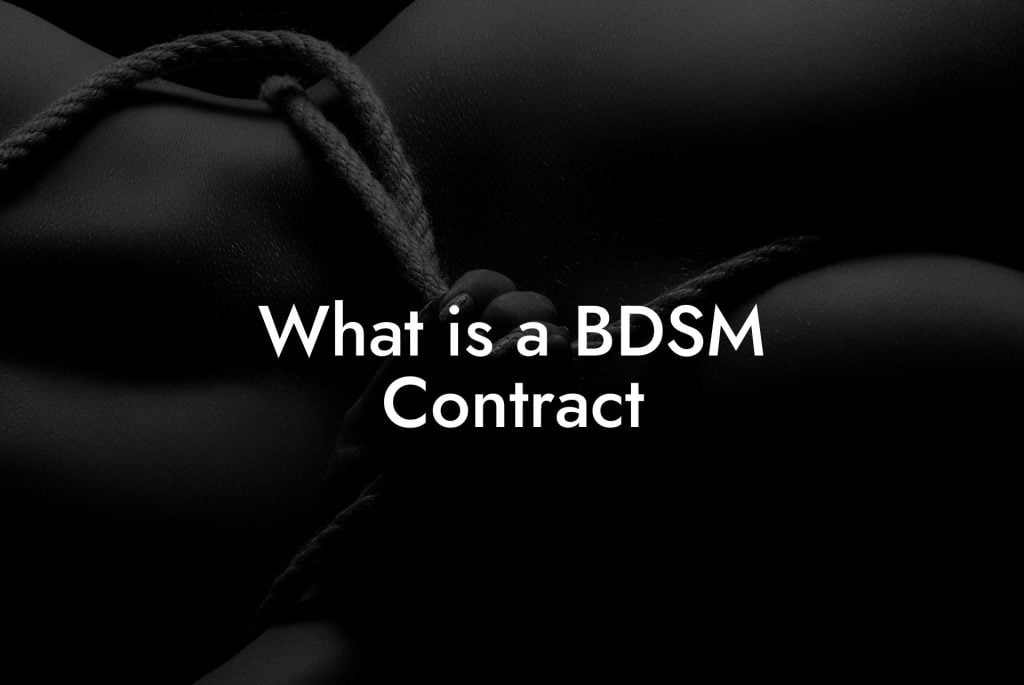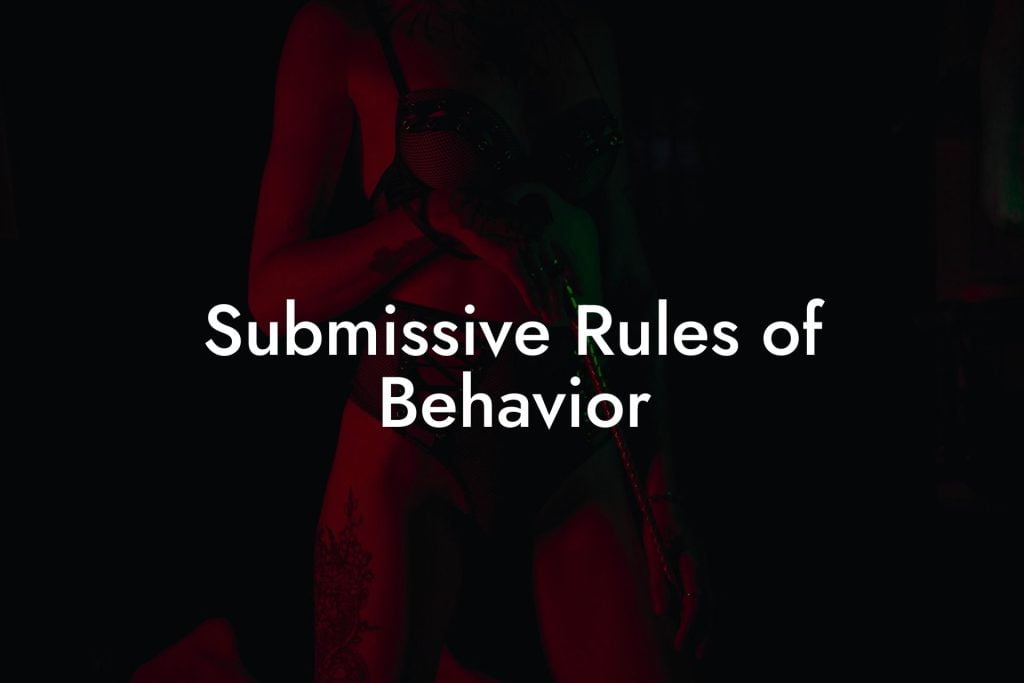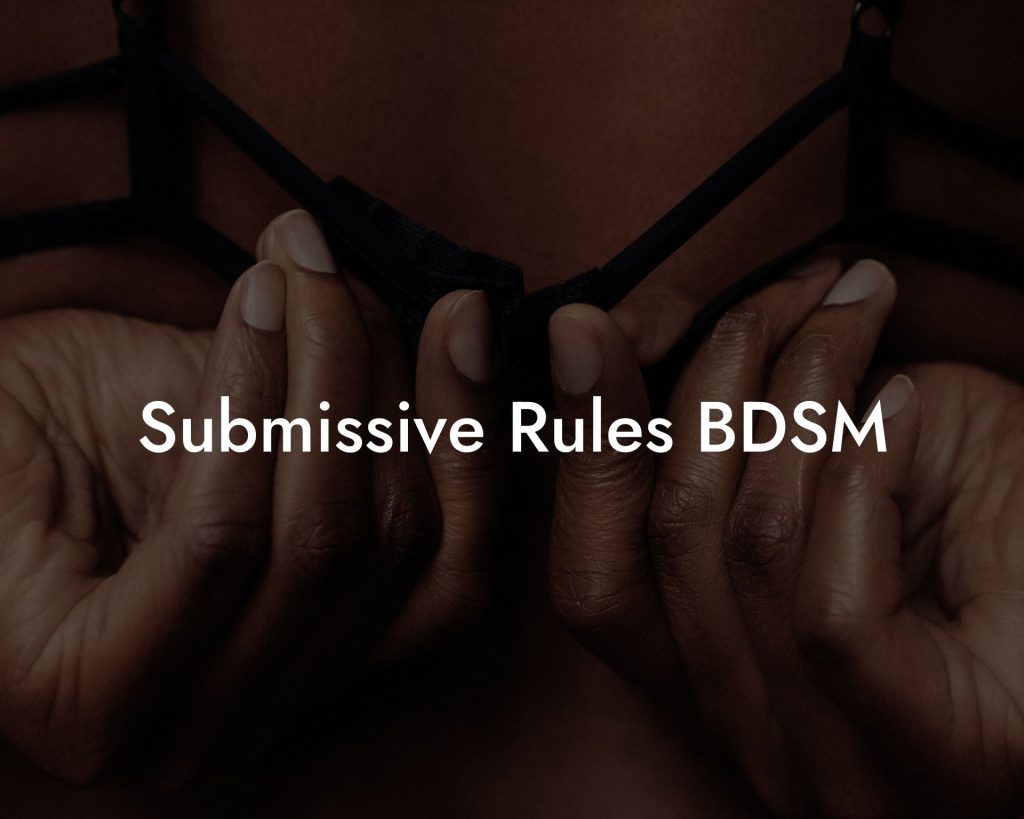In the realm of BDSM, establishing rules for your submissive is crucial for a healthy and fulfilling Dom/sub relationship. These rules serve as guidelines that define boundaries, ensure consent, and maintain trust between the Dominant and the submissive. In this article, we will explore some essential rules for your submissive, allowing you to create a safe and exciting environment for both parties involved.
In any BDSM relationship, consent is the cornerstone of trust and respect. It’s more than just saying “yes” or “no”—it’s about openly communicating your desires, limits, and expectations. But trust doesn’t end with a conversation—it’s built through ongoing, clear agreements. That’s where our Dominant & Submissive BDSM Contract Pack comes in. Find out more →
Establishing Trust and Consent
Creating a strong foundation of trust is vital in any Dom/sub relationship. Without trust, the power exchange dynamic cannot flourish. Begin by establishing open and honest communication, where both the Dominant and the submissive can express their desires, limits, and concerns. Consent is the cornerstone of BDSM, and it is essential to obtain explicit consent from your submissive for every activity. Use safe words and discuss any potential triggers or vulnerabilities to ensure a safe and consensual experience.
Setting Boundaries and Limits
Every submissive has their unique boundaries and limits that must be respected. Have an in-depth discussion with your submissive to identify and define these boundaries. Explore physical limitations, emotional triggers, and any hard limits that may exist. Respect these boundaries at all times, as crossing them without consent can lead to breach of trust and emotional harm. Remember, the submissive has the power to set their limits, and the Dominant's responsibility is to honor and protect them.
Consistency and Structure
Consistency and structure are essential aspects of a Dom/sub relationship that provide reassurance and clarity. Establish a set of rules that both parties agree upon, covering areas such as behavior, rituals, and protocols. These rules help to reinforce the power exchange dynamic, providing a sense of security and guidance for the submissive. Consistency in enforcing these rules helps to maintain the power balance and reinforces the Dominant's authority.
Discipline and Punishment
Discipline and punishment play a vital role in maintaining accountability and growth within a Dom/sub relationship. However, it is crucial to establish clear and fair guidelines for discipline. Discuss and agree upon the types of punishments that are acceptable and enjoyable for both parties. Remember, punishment should never result in physical or emotional harm, and it should always be within the boundaries of consent.
Looking for the best BDSM & Kink OnlyFans content creators? Here is a list of of our favourites that you will love:
-
- Best BDSM & Fetish OnlyFans - Molly✨ >> Link
- Best BBW & Huge Ass OnlyFans - Naughty Hanna Zimmer 💜🎀 >> Link
- Best Sexy Gaming Nerd OnlyFans - 🎮 Gracy EstuSWEET 🎮 >> Link
- Best Fetish & Kink Messaging OnlyFans - 💫Lola La Fleur 💫 >> Link
- Best Girl Next Door OnlyFans - ☀️Lily ⛅ >> Link
- Best Tiny European OnlyFans - 💝 Ami Allison 💝 >> Link
- Best Cosplay OnlyFans - 🐱 Little Kitty Kate 👉👌 >> Link
- Best Little OnlyFans - 🧸 Katya 🙇♀️ Sun >> Link
- Best Sub OnlyFans - 🍌Hanna Banana🍌 >> Link
- Best Teen & Huge Tits OnlyFans - ❣️Anny❣️19 y.o. BUSTY student girl >> Link
- Best Tiny Tits OnlyFans - ⍣⭐️ Sofia Parker ⭐️⍣ >> Link
- Best Sub & Huge Boobs OnlyFans - Nika Huge Boobs >> Link
- Best Kink OnlyFans - Sofia💖 >> Link
- Best Fetish & Girl Next Door OnlyFans - Hillary is Wet 💦 >> Link
- Best Dirty Latina OnlyFans - Paula Flores 😈 >> Link
Not quite what you are looking for? View the full list →
Frequently Asked Questions
What is a BDSM contract?
A BDSM contract is a document that outlines the expectations, limits, roles, and responsibilities of the parties involved in a BDSM relationship. It is used to ensure clear communication and consent between the parties and can help to foster trust and safety.
Is a BDSM contract legally binding?
While a BDSM contract may help clarify the dynamics and responsibilities in a relationship, it is generally not considered legally binding. BDSM activities may reside in a legal grey area, and enforcing such a private agreement can be complex.
How do consent and negotiation play a role in BDSM?
Consent and negotiation are critical in BDSM. All activities should be based on the clear, informed, and voluntary agreement of all parties. Prior to any activity, negotiations should cover limits, safewords, and specific actions to ensure a mutual understanding.
What are "hard limits" and "soft limits"?
Hard limits are non-negotiable boundaries that must not be crossed under any circumstances. Soft limits are activities that one might be hesitant to try but may be open to exploring with proper communication and agreed-upon conditions.
How important is trust in a BDSM relationship?
Trust is paramount in a BDSM relationship. It involves believing that one's partner will respect boundaries, listen to safewords, and prioritize safety and consent. Trust takes time to build and is fundamental to a positive and fulfilling BDSM experience.
What is a safeword, and how is it used?
A safeword is a pre-negotiated word or signal that participants in BDSM can use to communicate the need to pause, slow down, or stop the activity altogether. It is an essential tool for maintaining consent and safety.
Can someone withdraw consent during a BDSM scene?
Yes, anyone can withdraw consent at any time during a BDSM scene, even if they previously agreed to participate. Using the agreed-upon safeword or signals can communicate this retractment of consent.
How can one ensure safety during a BDSM scene?
Ensuring safety involves open communication, setting clear limits, using safewords, and being prepared with safety equipment like first aid kits or cutting tools to release bonds if necessary. Knowledge of proper techniques and continuous monitoring of each participant's wellbeing is also critical.
Are BDSM activities always sexual?
No, BDSM activities are not always sexual. While they can include sexual elements, BDSM can also focus on power dynamics, pain play, sensual stimulation, or emotional exchanges that don't involve sex.
What should I do after a BDSM scene?
Aftercare is recommended following a BDSM scene. It can involve physical care like treating any marks or providing comfort, or emotional care like discussing the experience and reinforcing the emotional connection between the participants.
What is "subspace" and "topspace"?
Subspace is a state of euphoria and altered consciousness that submissives may enter during a scene due to the release of endorphins. Top space is an equivalent state for dominants that may induce feelings of control, focus, and pleasure.
How do you negotiate a BDSM contract?
To negotiate a BDSM contract, you should discuss your desires, limits, expectations, roles, and responsibilities. Ensure that it is a mutual, informed, and voluntary process. The contract can be adjusted as needed with ongoing communication.
Can BDSM activities cause harm if not practiced properly?
Yes, BDSM activities have the potential to cause physical or emotional harm if not practiced responsibly. Engaging in activities without consent, proper knowledge, safety measures, or regard for limits can lead to injuries or trauma.
Is it possible to have a BDSM relationship without a contract?
Yes, it is possible to have a BDSM relationship without a formal contract, as long as all parties involved have a clear understanding of boundaries, expectations, and consent. Communication is key in any BDSM dynamic.
What is the role of a dominant in BDSM?
The role of a dominant in BDSM is to take control and make decisions within the agreed-upon limits and rules. They lead the scene and are responsible for the wellbeing of their submissive(s).
What is the role of a submissive in BDSM?
The role of a submissive in BDSM is to relinquish control within the negotiated boundaries. They follow the dominant’s lead and communicate their limits, needs, and reactions throughout the experience.
How does one ensure that a BDSM relationship stays healthy?
To ensure that a BDSM relationship stays healthy, maintain open communication, respect each other's limits, offer mutual support, practice responsible and safe play, and provide necessary aftercare. Regular check-ins and honest conversations about feelings and needs are also important.
How can beginners learn about safe BDSM practices?
Beginners can learn about safe BDSM practices through educational resources such as books, workshops, community events, online forums, and by talking to experienced practitioners. It's essential to gain a solid understanding of the risks involved and how to minimize them before starting.
What if someone feels ashamed or guilty after participating in BDSM?
It’s not uncommon for individuals to experience feelings of shame or guilt after participating in BDSM activities, often due to societal stigma. Engaging in open dialogue with supportive community members, seeking professional counseling, and affirming one's own limits and desires can help in managing these feelings.
Can a BDSM relationship evolve over time?
A BDSM relationship, like any other, can indeed evolve over time. The desires, limits, and dynamics between partners can change, necessitating revisions to the BDSM contract or the way in which participants engage with one another.
Rules for Your Submissive Example:
Rules for Your Submissive Example: Let's say you have established a rule for your submissive to ask for permission before speaking. If the submissive forgets to ask for permission, a suitable punishment could be a temporary loss of privileges, such as restricting their ability to indulge in certain activities or receive rewards. This punishment reinforces the importance of following the established rules and encourages better adherence in the future.













